Farm description
The farm is a conventional farm with external replacements located in Piedmont, Italy in an area with a high pig density. The nearest farm is about 500 meters away.

The farm consists of about 300 sows with Danish genetics that are inseminated with Talent sire line organized in 35-day batches; piglets are weaned at 26 days with an average weight of about 6 kg. The average born alive is 14.3 piglets per farrowing, 12.3 weaned, with a preweaning mortality of 13.9%. The main causes of death include those related to low birth weight of some piglets, sporadic enteric problems, and streptococcus. Twenty-five percent of production is retained on-site at the sow farm until they reach 30 kg and 75% are moved to the nursery site at weaning.
Replacement gilts arrive 4 times per year from a PRRSv negative farm with a good health status, a GP nucleus owned by the same producer.
Upon entry, they are housed in a quarantine room for 90 days during which vaccinations and acclimatization are done.
The vaccination plan for breeding animals includes immunization for Aujeszky's disease, PRRSV, influenza, PCV2, Mycoplasma, E. coli, clostridia, atrophic rhinitis, pleuropneumonia, Glasser's disease, erysipelas, and parvovirus. Piglets are vaccinated at 21 days against PRRSv, PCV2, and Mycoplasma.
For monitoring, analysis of processing fluids (testes) is performed in each batch for PRRSv analysis by RT-PCR, and the farm is not stable.
Sows are housed in gestation crates for estrus stimulation and insemination, followed by a body condition recovery phase; they are then moved to gestation in groups, with pens of 6 to 12 animals, and fed only once a day to reduce conflicts within the group.
The farrowing rooms are traditional: individual pens with the sow in a crate for the entire lactation period, slatted floor suitable for the piglets and solid floor in the nest area. The temperature in the room is maintained at around 24 degrees Celsius while the nest is maintained at 29 degrees using infrared lamps during the first 10 days of the piglets' life. Between the third and fifth day they are treated with iron and toltrazuril and at the same time tail docking and castration are performed. Sows are brought to the farrowing room five days before farrowing, where they are fed three times a day and have plenty of water available.
Feeding
The producer has a feed mill where the feed is produced by purchasing raw materials and a Vitamin Mineral Premix.
The raw materials are tested to characterize the most common nutrients and mycotoxins. In addition to providing a mineral supplement, the premix contains a good level of vitamins B, E (110 mg) and polyphenols with antioxidant function.
Trace elements are partially supplied in organic form and the value of the hepatoprotectants choline and betaine is quite high.
The feed is corn and soybean based but also includes high levels of barley and pulp to achieve high levels of functional fiber, thanks also to the good amount of thick bran; in particular, this occurs in the pre-farrowing phase thanks to the use of a specific feed.
Three feeds are used for sows: lactation, gestation, and pre-farrowing.
Formulation/analysis
| Type of feed: Gestation | |
|---|---|
| Ingredient | Amount % |
| Corn | 30.00 |
| Soybean meal (48% CP) | 10.00 |
| Bran | 26.00 |
| Barley | 20.00 |
| Soybean oil | 1.00 |
| Rice bran | 5.00 |
| Pulp | 3.00 |
| Premix | 5.00 |
| Total | 100.00 |
| Analytical characteristics | |
| Crude protein | 13.80% |
| Crude fat | 4.50% |
| Crude fiber | 6.10% |
| Ash | 6.10% |
| Digestible energy | 2,995 |
| Calcium | 0.90% |
| Phosphorus | 0.70% |
| Total lysine | 0.65% |
| Type of feed: Lactation plus | |
|---|---|
| Ingredients | Amount % |
| Corn | 30.00 |
| Soybean meal (48% CP) | 18.00 |
| Bran | 15.00 |
| Barley | 15.00 |
| Soybean oil | 1.50 |
| Pulp | 3.00 |
| High energy premix | 8.00 |
| Lard | 1.50 |
| Rice bran | 3.00 |
| Premix | 5.00 |
| Total | 100.00 |
| Analytical characteristics | |
| Crude protein | 16.20% |
| Crude fat | 6.50% |
| Crude fiber | 4.80% |
| Ash | 5.90% |
| Digestible energy | 3,290 |
| Calcium | 0.95% |
| Phosphorus | 0.70% |
| Total lysine | 1.00% |
| Type of feed: Prefarrowing sow light | |
|---|---|
| Ingredients | Amount % |
| Corn | 16.00 |
| Soybean meal (48% CP) | 7.00 |
| Bran | 22.50 |
| Barley | 34.00 |
| High energy premix | 7.00 |
| Pulp | 9.00 |
| Soybean oil | 0.50 |
| Premix | 4.00 |
| Total | 100.00 |
| Analytical characteristics | |
| Crude protein | 13.10% |
| Crude fat | 3.60% |
| Crude fiber | 6.20% |
| Ash | 5.30% |
| Digestible energy | 2,985 |
| Calcium | 0.80% |
| Phosphorus | 0.60% |
| Total lysine | 0.75% |
Description of problem
In March 2021, a high incidence of severe lameness appeared in 12 to 17-day-old piglets- about 20% of the animals- with prevalent involvement of the distal part of the limb, severe edema of the coronary band and sole and, in some cases, it extended to the entire hoof: they were treated with antibiotic (amoxicillin) and topical spray with chlortetracycline with a good response and remission of the infection. However, in some cases, the tissues were so compromised that the hoof was lost.

Figure 1. Inflammation of the coronary band.

Figure 2. Lesion on sole of 15-day old piglet.
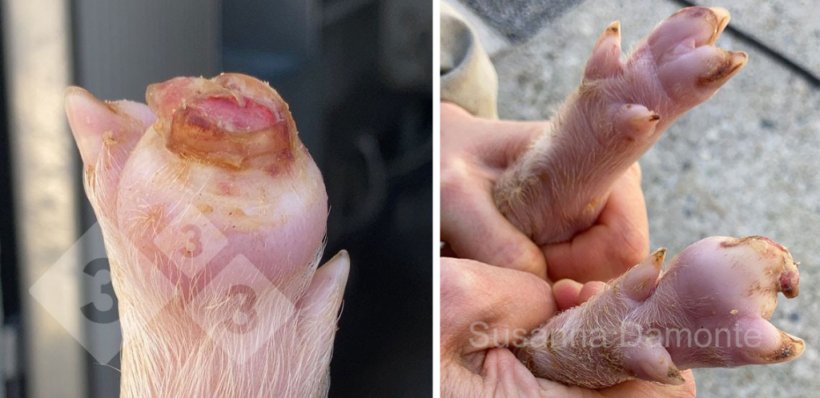
Figure 3. Hoof loss in 15-day old piglet.
The first diagnostic hypothesis was related to mechanical and environmental causes, suggesting the occurrence of wounds that were complicated by pathogens; the animals were then monitored for additional evidence. At the same time, the use of drying powders during farrowing was introduced.
As observations intensified in the following batches, inflammatory and necrotic lesions were independently observed in recently born pigs involving the hoof pad and the coronary band, in some cases the umbilicus, tail, and teats.
The set of lesions, which also appeared very early, led us to rule out direct a primary mechanical cause and to suspect an endogenous origin.
Therefore, the suspicion arose that it was a case of the recently identified SINS syndrome (swine inflammation and necrosis syndrome).
Syndrome description
SINS (Swine inflammation and necrosis syndrome, described by G. Reiner et al., 2021) is a syndrome characterized by inflammation and necrosis, especially of the most peripheral tissues, as a consequence of microcirculatory lesions (hyperemia and/or vasoconstriction, edema, thrombi, proliferation of the tunica intima, infiltration of granulocytes and macrophages).
The syndrome is triggered by the activation of the immune system and the inflammatory cascade and by numerous concomitant causes ranging from environmental (thermoregulation) and psychological (competition) stress situations, food, water and air quality, or infections. All this may involve the release into the bloodstream of various proinflammatory molecules (endotoxins, mycotoxins, lipopolysaccharides,Microbe-associated molecular patterns- MAMPs) both from the organism itself and from the intestinal microbiota when they are able to overcome the intestinal barrier and the detoxifying capacity of the liver.
The lesions compromise animal welfare and the syndrome has been linked to the quality of the sow. Signs of SINS can also be observed at weaning and finishing. (Reiner et al., 2020).
Genetic predisposition is investigated among the predisposing factors for susceptibility to this syndrome (Reiner et al., 2021).
Subsequent investigation
1- Three-day-old piglets from 29 litters were examined with reference to the clinical study presented by G. Reiner et al. to identify the prevalence of lesions (Reiner et al., 2019).
Out of 403 piglets evaluated (without assessing the specific grade), all of them presented lesions located in one or more areas at the same time:
- 399 (99.1%) on the hoof pad and coronary band
- 250 (62.03%) on the cheeks
- 50 (12.41%) at the base of the ears
- 17 (4.22%) on the tail
- 255 (63.28%) at the navel
- 44 (10.92%) on the teats

Figure 4. Lesions on the navel and teats.
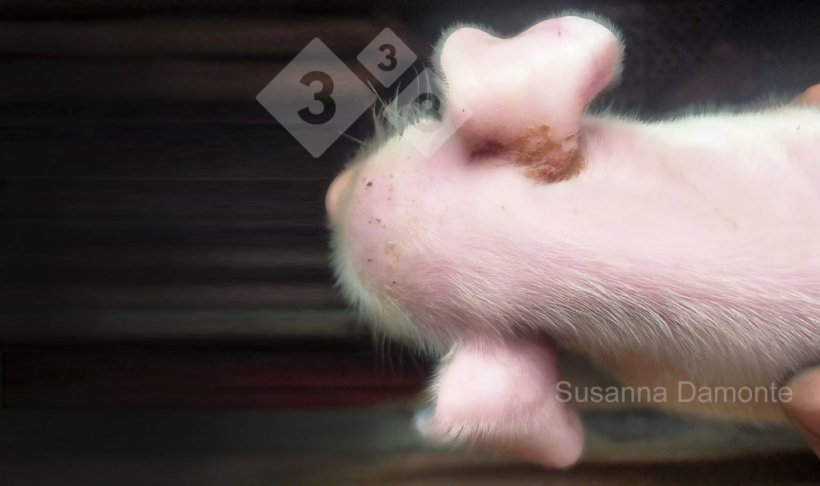
Figure 5. Lesions at the base of the ears.

Figure 6. Podal lesions (hoof pad and coronary band) at 4 days of age.
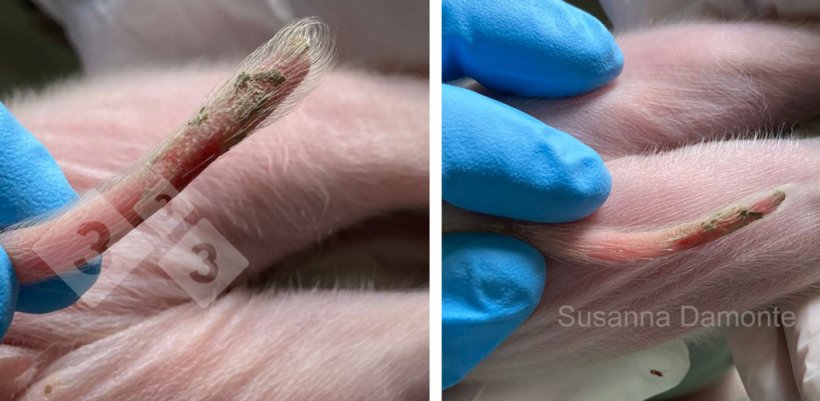
Figure 7. Lesions on the tail.
2- Tissue samples were sent to the University of Turin to verify that the lesions were histologically compatible with the images described in literature (Kuehling et al. 2020).

Figure 8. Navel. Locally widespread dermal area consisting of fibroplasia with activated fibroblasts and numerous immature small vessels (newly formed granulation tissue), multifocal inflammatory infiltrate with predominance of lymphoplasmacellular cells; in some vascular structures there is a granulocytic inflammatory infiltrate surrounding the vessel wall and focally infiltrating it (leukocytoclastic vasculitis).
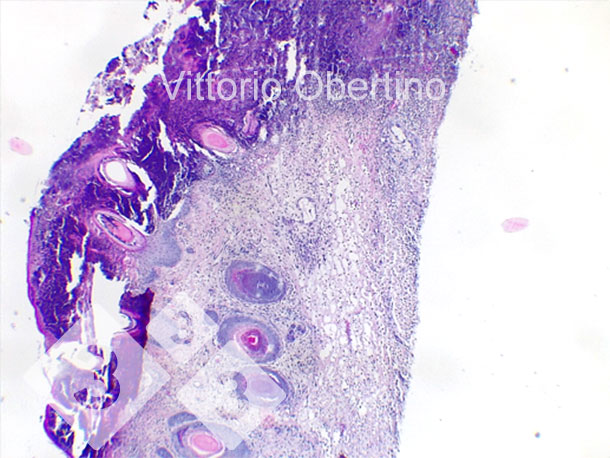
Figure 9. Skin. Focal epithelial erosion in which the superficial layer is replaced by abundant amorphous to granular eosinophilic material with karyorrhectic debris (necrosis) and abundant degenerate, viable neutrophilic granulocytes. Multifocally, the epithelium appears moderately to markedly hyperplastic with moderate to severe orthokeratotic hyperkeratosis. Multifocal presence of crusting is also observed. The dermis appears diffuse and moderately fibrotic.
3- Feed controls were performed and revealed no significant deviations in nutritional parameters. Mycotoxin monitoring found very low values; only ergot alkaloid levels showed levels of possible significance. Strangely high levels of phytoestrogens were observed, but the origin and significance remain to be explored.
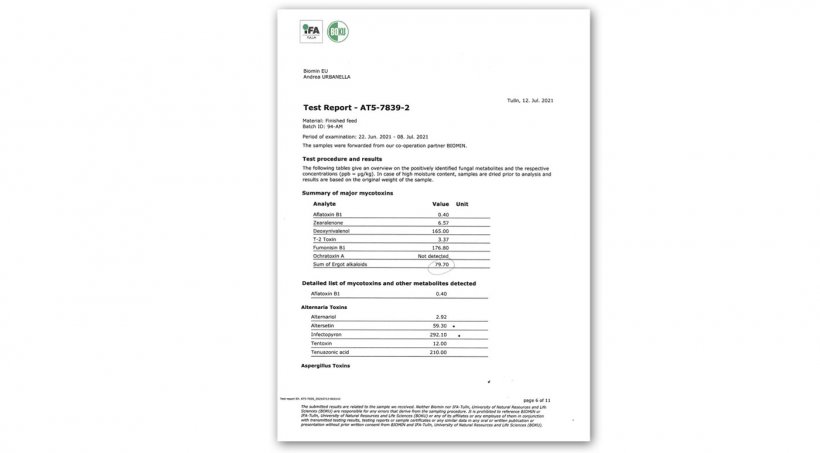
Figure 10. Microtoxins test.
4- Coprostasis was observed in sows in the farrowing room and in gestation.
5- The presence of skin alterations and edema at mammary level was sporadically detected in farrowing sows.

Figure 11. Mammary lesion in a lactating sow.
Corrective measures
- A broad-spectrum additive based on sequestarnts and enzymes has been introduced in the feed.
- The level of fiber was slightly increased and, above all, its structure was modified by replacing bran for thick bran.
- A peroxide disinfection system was introduced for the drinking water.
- Daily administration of straw (100 g per head per day) was carried out during the gestation phase.
Conclusions
In summary, in light of the compiled elements:
- The presence of clinical lesions and histological picture.
- Mammary lesions and coprostasis observed in sows.
The suspicion of a case of swine inflammatory and necrosis syndrome is confirmed.
The efficacy of the corrective measures taken will be evaluated in the coming months.
Acknowledgments
- Thank you to Dr. Raffaella Demaria representing the University of Turin Department of Veterinary Sciences.
- Thank you to the company Allevamenti 1910 Andorno for their constant collaboration.
- Thank you to Dr. Ettore Bosco for his field monitoring.








